Origin and Heavy Metals of Plagio-Granites in Egyptian Shield Oceanic Complexes: A Case Study of Abu Dabbab Area, Central Eastern Desert, Egypt
Abstract
:1. Introduction
2. Geologic Setting
3. Materials and Methods
4. Results and Discussion
4.1. Petrography
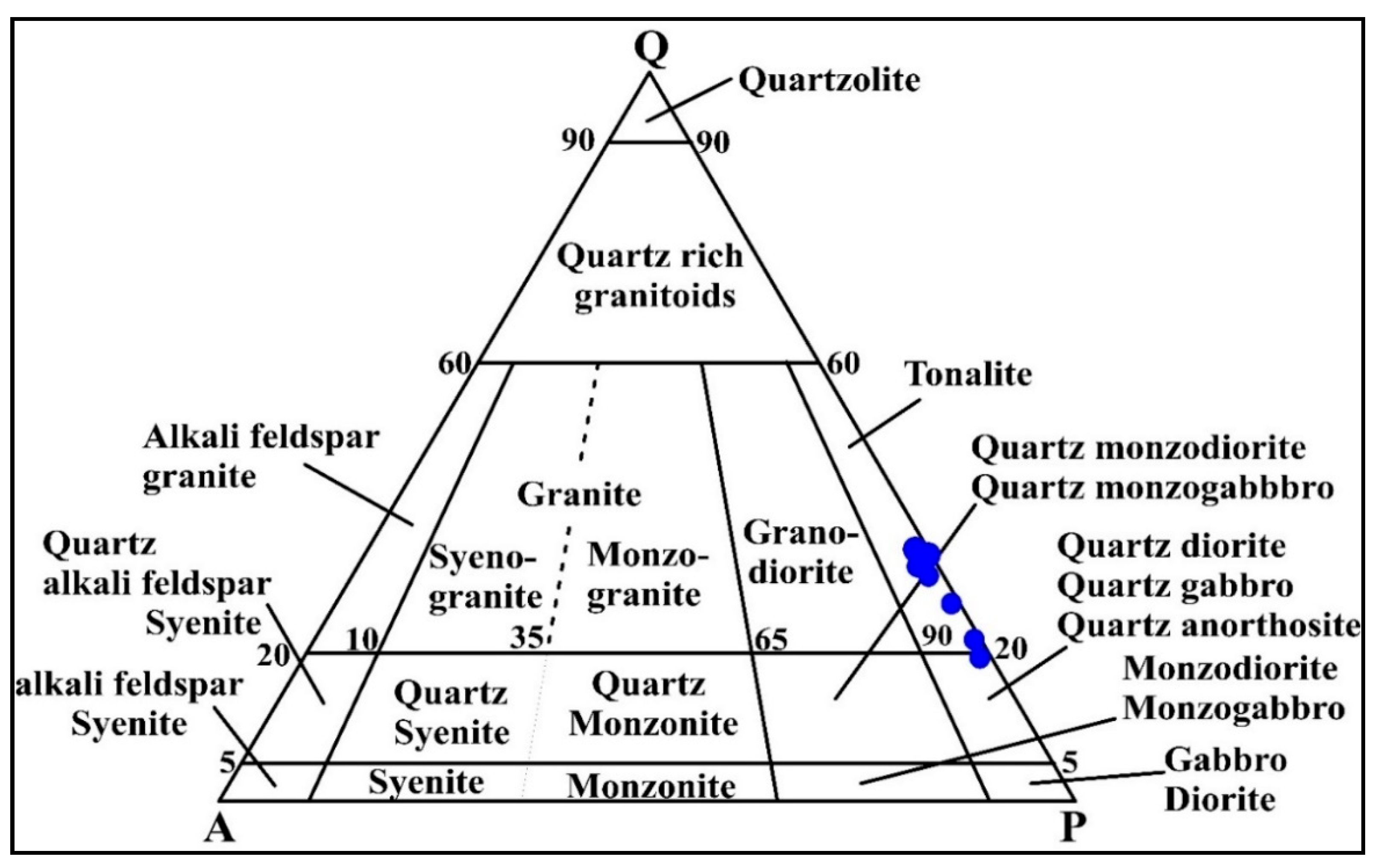
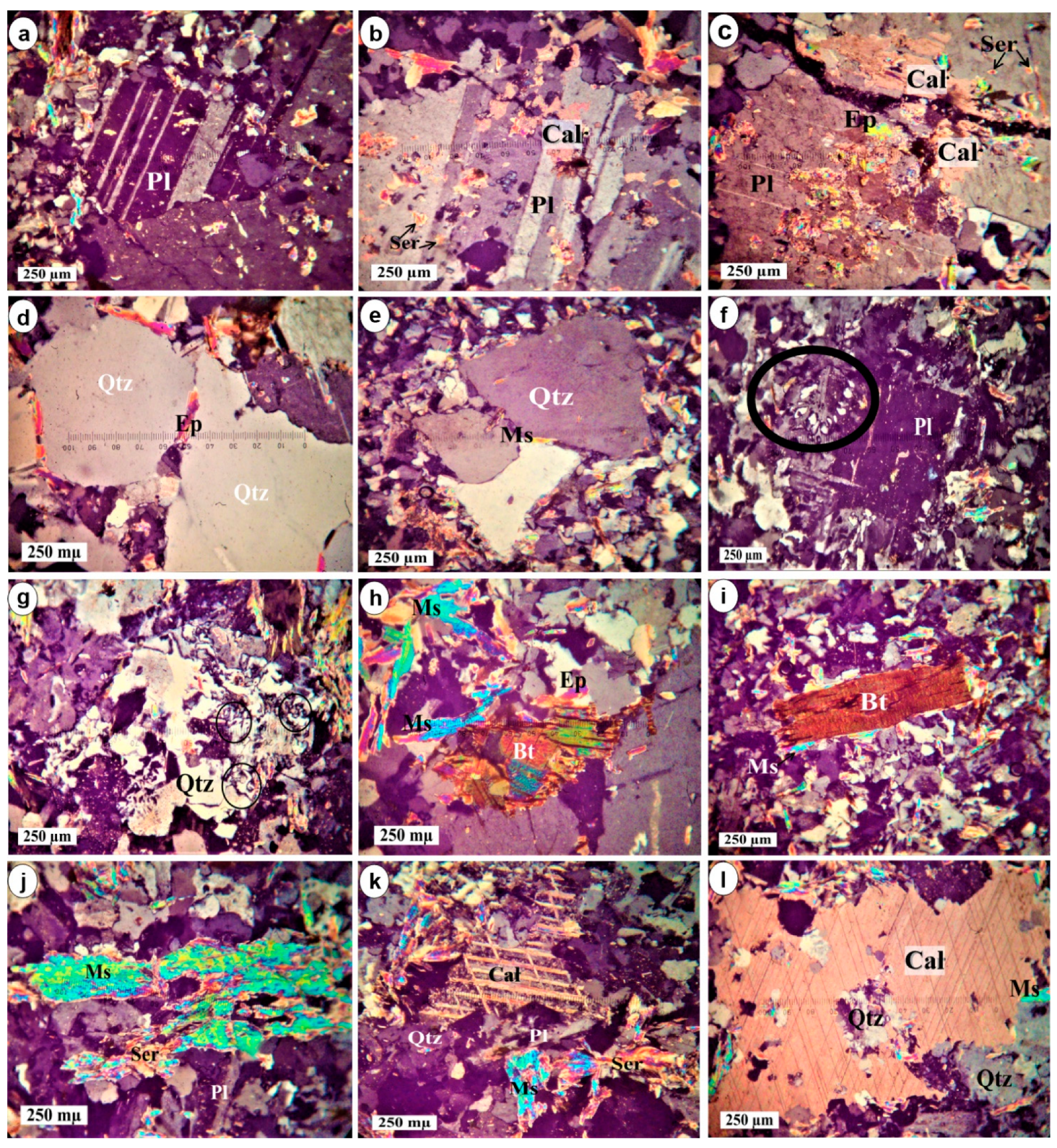
4.2. Whole-Rock Geochemistry
- Low-Al plagio-granite (TTG-type; having < 15 wt.% Al2O3 at 70 wt.% SiO2 < 200 ppm Sr, slightly enriched LREEs, and flat HREEs with a negative Eu-anomaly).
- High-Al type plagio-granite (having Al2O3 contents > 15 wt% at 70 wt.% SiO2, high Sr > 300 ppm, low Yb < 1.8 ppm, low Nb < 11 ppm, low to moderate K/Rb ratios < 750 ppm, enriched LREEs, depleted HREEs, and have no, or only a slight, Eu anomaly).
| Major Oxides (wt. %) | ||||||||||||||
|---|---|---|---|---|---|---|---|---|---|---|---|---|---|---|
| 1a | 1b | 2a | 2b | 3a | 3b | 3c | 4 | 9 | 10 | AP1 | AP2 | AP3 | AP4 | |
| SiO2 | 73.36 | 73.12 | 74.10 | 71.18 | 70.66 | 71.12 | 73.07 | 73.69 | 72.14 | 70.81 | 72.21 | 74.10 | 64.60 | 72.39 |
| TiO2 | 0.22 | 0.21 | 0.20 | 0.28 | 0.23 | 0.19 | 0.21 | 0.23 | 0.23 | 0.28 | 0.22 | 0.27 | 0.12 | 0.18 |
| Al2O2 | 14.01 | 13.02 | 13.21 | 14.04 | 13.91 | 13.75 | 14.01 | 14.25 | 14.34 | 13.49 | 13.79 | 13.73 | 13.21 | 15.08 |
| Fe2O3 | 1.65 | 1.07 | 1.60 | 1.03 | 1.66 | 1.01 | 1.56 | 1.17 | 1.62 | 1.61 | 1.36 | 3.69 | 3.10 | 0.33 |
| FeO | 0.62 | 0.73 | 0.71 | 0.65 | 0.59 | 0.63 | 0.46 | 0.53 | 0.70 | 0.65 | 0.62 | 0.30 | 2.10 | 0.15 |
| MnO | 0.06 | 0.07 | 0.03 | 0.05 | 0.05 | 0.06 | 0.05 | 0.05 | 0.05 | 0.06 | 0.05 | 0.07 | 0.06 | 0.02 |
| MgO | 0.61 | 0.55 | 0.56 | 0.57 | 0.60 | 0.55 | 0.62 | 0.51 | 0.51 | 0.52 | 0.55 | 0.52 | 0.49 | 1.89 |
| CaO | 1.71 | 1.79 | 1.68 | 1.48 | 1.31 | 1.51 | 1.53 | 1.65 | 1.72 | 1.81 | 1.6 | 0.51 | 3.30 | 2.60 |
| Na2O | 6.61 | 8.01 | 6.80 | 9.02 | 9.58 | 9.98 | 6.85 | 6.57 | 7.55 | 9.61 | 8.2 | 4.67 | 4.10 | 6.40 |
| K2O | 0.02 | 0.10 | 0.32 | 0.13 | 0.60 | 0.17 | 0.22 | 0.08 | 0.11 | 0.01 | 0.17 | 1.59 | 2.20 | 0.28 |
| P2O5 | 0.08 | 0.08 | 0.08 | 0.12 | 0.03 | 0.10 | 0.10 | 0.13 | 0.07 | 0.09 | 0.08 | 0.18 | 0.19 | - |
| LOI | 0.81 | 0.85 | 0.71 | 0.60 | 0.68 | 0.90 | 1.01 | 1.02 | 0.75 | 0.90 | 0.83 | - | 6.3 | 0.67 |
| Total | 99.76 | 99.60 | 100 | 99.15 | 99.90 | 99.97 | 99.69 | 99.88 | 99.79 | 99.84 | 99.77 | 99.63 | 99.77 | 99.99 |
| Trace elements (ppm) | ||||||||||||||
| V | 21 | 17 | 22 | 14 | 20 | 24 | 18 | 19 | 18 | 17 | 19.45 | - | - | - |
| Cr | 4.11 | 4.95 | 4.51 | 6.05 | 5.21 | 4.62 | 6.01 | 4.21 | 5.52 | 4.38 | 4.92 | - | - | 15.17 |
| Co | 1.22 | 7.30 | 7.21 | 7.41 | 1.55 | 7.51 | 1.11 | 1.10 | 1 | 1.20 | 4.01 | - | - | 3.25 |
| Rb | 90 | 90 | 82 | 89 | 76 | 85 | 80 | 88 | 88 | 85 | 85.27 | - | - | 4.48 |
| Ba | 487 | 448 | 458 | 441 | 485 | 444 | 436 | 469 | 445 | 438 | 454.09 | - | - | 71.81 |
| Sr | 99 | 127 | 128 | 122 | 117 | 120 | 117 | 100 | 111 | 125 | 116.9 | - | - | 318.60 |
| Nb | 78 | 81 | 65 | 76 | 77 | 71 | 68 | 70 | 79 | 72 | 73.45 | - | - | 0.80 |
| Ta | 0.37 | 0.52 | 0.51 | 0.51 | 0.72 | 0.31 | 0.38 | 0.35 | 0.74 | 0.72 | 0.49 | - | - | 0.12 |
| Zr | 131 | 147 | 150 | 150 | 162 | 155 | 146 | 164 | 141 | 133 | 148.5 | - | - | 78.60 |
| Hf | 3.10 | 3 | 3 | 3 | 4 | 3.21 | 3 | 3.23 | 3.51 | 3 | 3.2 | - | - | 3.09 |
| Y | 30 | 38 | 34 | 31 | 20 | 30 | 22 | 24 | 30 | 23 | 28.36 | - | - | 5 |
| Pb | 58 | 65 | 52 | 59 | 49 | 55 | 57 | 60 | 62 | 55 | 57 | - | - | |
| Cu | 7 | 9 | 7 | 11 | 9 | 8 | 8 | 10 | 7 | 8 | 8.36 | - | - | |
| Zn | 42 | 42 | 36 | 44 | 41 | 44 | 50 | 43 | 42 | 38 | 42.36 | - | - | 14.20 |
| U | 4.7 | 5.07 | 4.9 | 6.01 | 6.2 | 5.8 | 5 | 6.2 | 4.7 | 5 | 5.39 | - | - | 0.31 |
| Th | 14.3 | 13.07 | 14.8 | 16.08 | 16.1 | 15.5 | 15.1 | 16.4 | 14.8 | 15.2 | 15.16 | - | - | 1.98 |
| Rare earth elements (ppm) | ||||||||||||||
| La | 75 | 78 | 81 | 75 | 80 | 74 | 88 | 74 | 77 | 69 | 77.1 | - | - | 2.20 |
| Ce | 175 | 158 | 171 | 168 | 175 | 155 | 167 | 145 | 152 | 165 | 163.1 | - | - | 4.84 |
| Pr | 4 | 4 | 4 | 4 | 4 | 6 | 4 | 6 | 6 | 7 | 4.9 | - | - | 0.78 |
| Nd | 76 | 84 | 81 | 78 | 61 | 64 | 55 | 64 | 63 | 71 | 69.7 | - | - | 3.58 |
| Sm | 10 | 16 | 11 | 14 | 11 | 12 | 12 | 15 | 10 | 11 | 12.2 | - | - | 0.89 |
| Eu | 1 | 1 | 1 | 1 | 1 | 1 | 1 | 1 | 1 | 1 | 1 | - | - | 0.31 |
| Gd | 3 | 6 | 5 | 4 | 5 | 6 | 6 | 6 | 4 | 5 | 5 | - | - | 0.83 |
| Tb | 1 | 1 | 1 | 1 | 1 | 1 | 1 | 1 | 1 | 1 | 1 | - | - | 0.12 |
| Dy | 3 | 4 | 4 | 3 | 5 | 3 | 3 | 4 | 5 | 5 | 3.9 | - | - | 0.74 |
| Ho | 1 | 1.20 | 1 | 1.80 | 1 | 0.84 | 1 | 0.85 | 0.86 | 0.81 | 1.04 | - | - | 0.16 |
| Er | 1 | 1 | 1 | 1 | 1 | 1 | 1 | 1 | 1 | 1 | 1 | - | - | - |
| Tm | 0.30 | 0.71 | 0.34 | 0.35 | 0.41 | 0.38 | 0.37 | 0.44 | 0.71 | 0.79 | 0.48 | - | - | 0.09 |
| Yb | 2 | 2 | 2 | 3 | 2 | 1 | 2 | 2 | 1 | 2 | 1.9 | - | - | 0.52 |
| Lu | 1 | 1 | 1 | 1 | 1 | 1 | 1 | 1 | 1 | 1 | 1 | - | - | 0.09 |
| CIPW norm | ||||||||||||||
| Albite | 55.5 | 65.87 | 57.12 | 70.86 | 69.16 | 57.54 | 55.21 | 55.5 | 63.3 | 68.73 | - | - | - | - |
| Anorthite | 7.90 | - | 4.54 | 6.78 | 7.29 | 6.2 | 4.87 | - | - | - | - | - | ||
| Apatite | 0.17 | 0.17 | 0.17 | 0.26 | 0.22 | 0.22 | 0.28 | 0.30 | 0.15 | 0.19 | - | - | - | - |
| Corundum | 0.20 | - | - | - | - | - | - | - | - | - | - | - | - | - |
| Hematite | 0.57 | - | 0.35 | - | - | 0.84 | 0.34 | 0.34 | 0.41 | - | - | - | - | - |
| Ilmenite | 0.41 | 0.40 | 0.38 | 0.53 | 0.36 | 0.40 | 0.43 | 0.44 | 0.43 | 0.53 | - | - | - | - |
| Magnetite | 1.55 | 0.94 | 1.79 | - | - | 1.03 | 1.20 | 1.20 | 1.74 | - | - | - | - | - |
| Orthoclase | 0.12 | 0.59 | 1.88 | 0.76 | 1 | 1.29 | 0.47 | 3.09 | 0.64 | 0.06 | - | - | - | - |
| Quartz | 30.27 | 23.38 | 29.60 | 17.03 | 16.80 | 28.28 | 31.02 | 29.62 | 24.0 | 18.79 | - | - | - | - |
| Diopside | - | 4.02 | 2.50 | 4.57 | 4.71 | 0.08 | - | - | 2.44 | 4.34 | - | - | - | - |
| Wollastonite | - | 1.38 | - | 0.37 | 0.43 | - | - | - | - | 1.25 | - | - | - | - |
| Acmite | - | 1.19 | - | 2.95 | 2.90 | - | - | - | - | 4.62 | - | - | - | - |
| Hyperthene | 1.51 | - | 0.23 | - | - | 1.49 | 1.26 | 1.27 | 0.13 | - | - | - | - | - |
| Corundum | - | - | - | - | - | - | 0.66 | 0.19 | - | - | - | - | - | - |
4.3. Petrogenesis
- The slightly enriched patterns of the LREEs in the studied plagio-granites as well as the negative anomalies of Eu, Sr, Y, and Ta; low concentrations of HREEs indicate that they were likely derived from the partial melting in a subduction zone;
- Greater enrichment in Pb, Nb, Ba, Rb, and light rare earth elements (LREEs) than for HREEs.
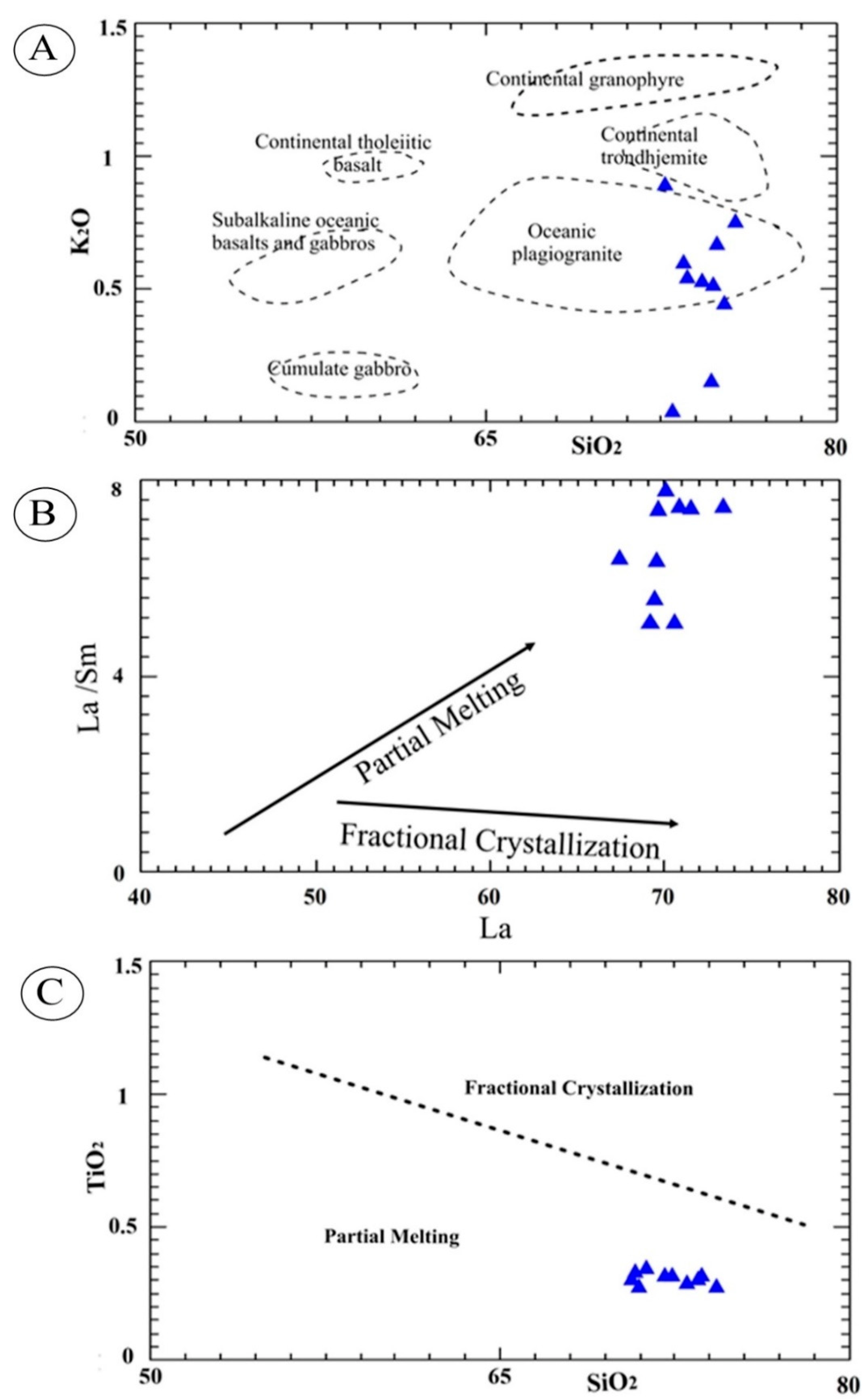

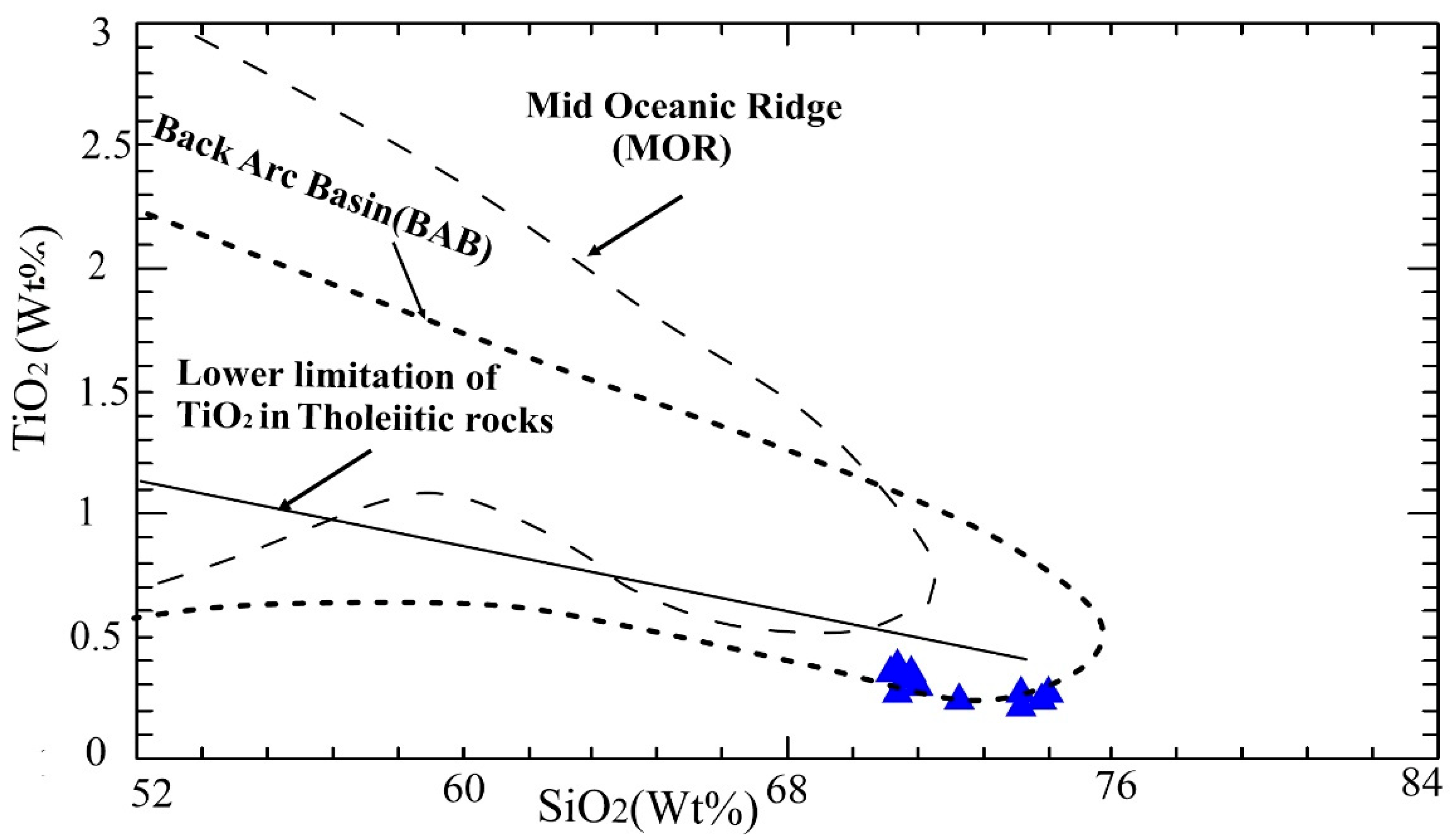

4.4. Natural Radioactive Elements:
4.5. Clarke Concentration
5. Conclusions
Author Contributions
Funding
Data Availability Statement
Acknowledgments
Conflicts of Interest
References
- Coleman, R.G.; Peterman, Z.E. Oceanic plagiogranite. J. Geophys. Res. 1975, 80, 1099–1108. [Google Scholar]
- Gillis, K.M.; Coogan, L.A. Anatectic migmatites from the roof of an ocean ridge magma chamber. J. Petrol. 2002, 43, 2075–2095. [Google Scholar] [CrossRef]
- Rollinson, H. The geochemistry of mantle chromitites from the northern part of the Oman ophiolite: Inferred parental melt compositions. Contrib. Miner. Pet. 2008, 156, 273–288. [Google Scholar]
- Tsuchiya, N.; Shibata, T.; Yoshikawa, M.; Adachi, Y.; Miyashita, S.; Adachi, T.; Nakano, N.; Osanai, Y. Petrology of Lasail plutonic complex, northern Oman ophiolite, Oman: An example of arc-like magmatism associated with ophiolite detachment. Lithos 2013, 156–159, 120–138. [Google Scholar]
- Awad, H.A.M.; Nastavkin, A.V. Some Mechanical and Physical Studies of Granitic Rocks in Um Taghir, Eastern Desert, Egypt. J. Phys. Conf. Ser. 2021, 1945, 012012. [Google Scholar]
- Awad, H.A.; Nastavkin, A.V. Geochemical and Geotectonic Setting for Island Arc Related rocks on Um Taghir Area, Central Eastern Desert, Egypt. IOP Conf. Ser. Earth Environ. Sci. 2021, 720, 012049. [Google Scholar]
- Rollinson, H. New models for the genesis of plagiogranites in the Oman ophiolite. Lithos 2009, 112, 603–614. [Google Scholar]
- Stakes, D.S.; Taylor, H.P., Jr. Oxygen isotope and chemical studies on the origin of large plagiogranite bodies in northern Oman, and their relationship to the overlying massive sulphide deposits. Geol. Soc. Lond. Spec. Publ. 2003, 218, 315–351. [Google Scholar]
- Coleman, R.G.; Donato, M.M. Oceanic plagiogranite revisited. Dev. Petrol. 1979, 6, 149–168. [Google Scholar]
- Dixon, J.E.; Lippard, S.J.; Shelton, A.W.; Gass, I.G. The Ophiolite of Northern Oman; Basil Blackwell: Oxford, UK, 1986. [Google Scholar]
- Malpas, J. Two contrasting trondhjemite associations from transported ophiolites in Western Newfoundland: Initial report. Dev. Petrol. 1979, 6, 465–487. [Google Scholar]
- Huang, S.; Wang, W.; Kerr, A.C.; Zhao, J.; Xiong, Q.; Wang, J. The Fuchuan Ophiolite in South China: Evidence for Modern-Style Plate Tectonics During Rodinia Breakup, Geochemistry, Geophys. Geosystems 2021, 22, e2021GC010137. [Google Scholar]
- Koepke, J.; Feig, S.T.; Snow, J.; Freise, M. Petrogenesis of oceanic plagiogranites by partial melting of gabbros: An experimental study. Contrib. Miner. Pet. 2004, 146, 414–432. [Google Scholar]
- Kröner, A.; Todt, W.; Hussein, I.M.; Mansour, M.; Rashwan, A. Dating of late Proterozoic ophiolites in Egypt and the Sudan using the single grain zircon evaporation technique. Precambrian Res. 1992, 59, 15–32. [Google Scholar]
- Zhang, Q.; Wang, C.Y.; Liu, D.; Jian, P.; Qian, Q.; Zhou, G.; Robinson, P.T. A brief review of ophiolites in China. J. Asian Earth Sci. 2008, 32, 308–324. [Google Scholar]
- Dilek, Y.; Furnes, H. Ophiolites and their origins. Elements 2014, 10, 93–100. [Google Scholar]
- Li, W.-X.; Li, X.-H. Adakitic granites within the NE Jiangxi ophiolites, South China: Geochemical and Nd isotopic evidence. Precambrian Res. 2003, 122, 29–44. [Google Scholar] [CrossRef]
- Freund, S.; Haase, K.; Keith, M.; Beier, C.; Garbe-Schönberg, D. Constraints on the formation of geochemically variable plagiogranite intrusions in the Troodos Ophiolite, Cyprus. Contrib. Miner. Pet. 2014, 167, 978. [Google Scholar]
- Liu, L.; Kang, L.; Cao, Y.; Yang, W. Early Paleozoic granitic magmatism related to the processes from subduction to collision in South Altyn, NW China. Sci. China Earth Sci. 2015, 58, 1513–1522. [Google Scholar]
- Yang, W.; Niu, H.; Hollings, P.; Zurevinski, S.E.; Li, N. The role of recycled oceanic crust in the generation of alkaline A-type granites. J. Geophys. Res. Solid Earth 2017, 122, 9775–9783. [Google Scholar]
- Rahman, E.M.A. Geochemical and Geotectonic Controls of the Metallogenic Evolution of Selected Ophiolite Complexes from the Sudan; Selbstverlag Fachbereich Geowissenschaften: Berlin, Germany, 1993. [Google Scholar]
- Patiño Douce, A.E.; McCarthy, T.C. Melting of crustal rocks during continental collision and subduction. In When Continents Collide: Geodynamics and Geochemistry of Ultrahigh-Pressure Rocks; Springer: Dordrecht, The Netherlands, 1998; Volume 10, pp. 27–55. [Google Scholar]
- El Shazly, E.M. The geology of the Egyptian region. In The Ocean Basins Margins; Nairn, A.E.M., Kanes, W.H., Stehli, F.G., Eds.; Springer: Boston, MA, USA, 1977; pp. 379–444. [Google Scholar]
- Gamal El Dien, H.; Li, Z.-X.; Abu Anbar, M.; Doucet, L.S.; Murphy, J.B.; Evans, N.; Xia, X.-P.; Li, J. The largest plagiogranite on Earth formed by re-melting of juvenile proto-continental crust. Commun. Earth Environ. 2021, 2, 138. [Google Scholar]
- Hassaan, M.M.; El-Desoky, H.M. Granites in the tectonic environs of the Nubian Shield, Egypt: Geochemical characterizations and new contributions. Curr Res. 2016, 10, 59–103. [Google Scholar]
- Wilson, M. Igneous Petrogenesis; Springer: Dordrecht, The Netherlands, 1989. [Google Scholar]
- Rollinson, H.R. A terrane interpretation of the Archaean Limpopo Belt. Geol. Mag. 1993, 130, 755–765. [Google Scholar] [CrossRef]
- Valković, V. Radioactive nuclides in nature. In Radioactivity in the Environment, 1st ed.; Elsevier: Amsterdam, The Netherlands, 2000. [Google Scholar]
- Awad, H.A.; Zakaly, H.M.; Nastavkin, A.V.; El Tohamy, A.M.; El-Taher, A. Radioactive mineralizations on granitic rocks and silica veins on shear zone of El-Missikat area, Central Eastern Desert, Egypt. Appl. Radiat. Isot. 2021, 168, 109493. [Google Scholar] [CrossRef]
- Mohamed, F.H. Rare metal-bearing and barren granites, Eastern Desert of Egypt: Geochemical characterization and metallogenetic aspects. J. Afr. Earth Sci. 1993, 17, 525–539. [Google Scholar] [CrossRef]
- Sabet, A.H. Tin-Tungsten and Rare-Metal Mineralization in the Central Eastern Desert of Egypt. Ann. Geol. Surv. Egypt 1973, 3, 75–86. [Google Scholar]
- Abu El-Leil, I.A. Geology, Petrography and Geochemistry of the Granitid Rocks of Abu Dabbab Area, Eastern Desert. Master’s Thesis, 1975. [Google Scholar]
- El-Tabal, H.K. Mineralogical Studies on Some Rare Metal Apogranites from Nuweibi and Abu Dabbab Areas, Eastern Desert, Egypt. Master’s Thesis, Al-Azhar University, Cairo, Egypt, 1979; pp. 1–112. [Google Scholar]
- Sabet, A.H.; Abu El-Leil, I. Geology and Petrography of the Granitic Rocks Along Wadi Abu-Dabbab, Eastern Desert, Egypt. Ann. Geol. Surv. Egypt 1985, 15, 123–128. [Google Scholar]
- Hamimi, Z.; Zoheir, B.A.; Younis, M.H. Polyphase deformation history of the Eastern Desert tectonic terrane in northeastern Africa. In Proceedings of the XII International Conference “New Ideas in Earth Sciences”, Moscow, Russia, 8–10 April 2015. [Google Scholar]
- Heikal, M.T.S.; Abd, M.; Monsef, E.; Goma, S.R.; Mansi, E.; Top, G. Natural Radionuclides Levels and their Geochemical Characteristics of Abu Dabbab Albite Granite Mining Area, Central Nubian Shield of Egypt. J. Environ. Hazard. 2019, 2, 10000111. [Google Scholar]
- El-Desoky, H.M. Geology, Geochemistry and Genetic Implications of the Greisen Deposits, Central Eastern Desert, Egypt. Ann. Geol. Surv. Egypt 2020, 37, 128–164. [Google Scholar]
- Renno, A. Zur Petrogenese der Albitgranite von Abu Dabbab und Nuweibi, Central Eastern Desert, Ägypten; Logos: Berlin, Germany, 1997. [Google Scholar]
- Helba, H.; Trumbull, R.B.; Morteani, G.; Khalil, S.O.; Arslan, A. Geochemical and petrographic studies of Ta mineralization in the Nuweibi albite granite complex, Eastern Desert, Egypt. Miner. Depos. 1997, 32, 164–179. [Google Scholar] [CrossRef]
- Sabet, A.H.; Tsogoev, V.B.; Sarin, L.P.; Azazi, S.A.; El Bedewi, M.A.; Ghobrial, G.A. Tin-tantalum deposit of Abu Dabbab. Ann. Geol. Surv. Egypt 1976, 6, 93–117. [Google Scholar]
- Daggett, P.H.; Morgan, P.; Boulos, F.K.; Hennin, S.F.; El-Sherif, A.A.; El-Sayed, A.A.; Basta, N.Z.; Melek, Y.S. Seismicity and active tectonics of the Egyptian Red Sea margin and the northern Red Sea. Tectonophysics 1986, 125, 313–324. [Google Scholar] [CrossRef]
- Pirajno, F.; Cawood, P.A. Hydrothermal Processes and Mineral Systems; Springer: Berlin, Germany, 2009. [Google Scholar]
- Wilcockson, W.H.; Tyler, W.H. On an area of ultrabasic rocks in the Kassala Province of the Anglo-Egyptian Sudan. Geol. Mag. 1933, 70, 305–320. [Google Scholar] [CrossRef]
- Rittmann, A. On the serial character of igneous rocks, Egypt. J. Geol. 1957, 1, 23–48. [Google Scholar]
- Shukri, N.M.; Lotfi, M. The geology of the Bir Barramiya area. Bull. Fac. Sci. Cairo Univ. 1959, 34, 83–130. [Google Scholar]
- Bogoch, R.; Magaritz, M. Immiscible silicate-carbonate liquids as evidenced from ocellar diabase dykes, southeast Sinai. Contrib. Miner. Pet. 1983, 83, 227–230. [Google Scholar] [CrossRef]
- Streckeisen, A. Plutonic rocks: Classification and nomenclature recommended by the IVGS sub-commission on the systematic of igneous rocks. Geotims 1973, 18, 26–30. [Google Scholar]
- Brown, E.H.; Bradshaw, J.Y.; Mustoe, G.E. Plagiogranite and keratophyre in ophiolite on Fidalgo Island, Washington. Geol. Soc. Am. Bull. 1979, 90, 493–507. [Google Scholar] [CrossRef]
- Sinton, J.M.; Byerly, G.R. Silicic differentiates of abyssal oceanic magmas: Evidence for late-magmatic vapor transport of potassium. Earth Planet. Sci. Lett. 1980, 47, 423–430. [Google Scholar] [CrossRef]
- Barker, F.; Arth, J.G. Generation of trondhjemitic-tonalitic liquids and Archean bimodal trondhjemite-basalt suites. Geology 1976, 4, 596–600. [Google Scholar] [CrossRef]
- Defant, M.J.; Drummond, M.S. Derivation of some modern arc magmas by melting of young subducted lithosphere. Nature 1990, 347, 662–665. [Google Scholar] [CrossRef]
- Botros, N.S. Geological and Geochemical Studies on Some Gold Occurrences in the North Eastern Desert, Egypt. Ph.D. Thesis, Zagazig University, Zagazig, Egypt, 1991; p. 146. [Google Scholar]
- Emam, A. Mineralogical and Geochemical Studies on Some Gold Deposits and Host Rocks, Wadi Allaqi, South Eastern Desert, Egypt. Ph.D. Thesis, South Valley University, Hurghada, Egypt, 2005. [Google Scholar]
- Torabi, G.; Morishita, T.; Arai, S. Two types of plagiogranite from Mesozoic Ashin ophiolite (Central Iran): A mark of tectonic setting change from Jurassic to Cretaceous. Geotectonics 2019, 53, 110–124. [Google Scholar]
- Hunter, D.R. The role of tonalitic and trondhjemitic rocks in the crustal development of Swaziland and the eastern Transvaal, South Africa. Dev. Petrol. 1979, 6, 301–322. [Google Scholar]
- Hietanen, A. Idaho Batholith near Pierce and Bungalow, Clearwater County, Idaho; United States Government Printing Office: Washington, DC, USA, 1963.
- O’Conner, J.T. A classification of quartz-rich igneous rocks based on feldspar ratios. US Geol. Surv. Prof. Pap. 1965, 82, 462–465. [Google Scholar]
- Hansen, J.; Skjerlie, K.P.; Pedersen, R.B.; De La Rosa, J. Crustal melting in the lower parts of island arcs: An example from the Bremanger Granitoid Complex, west Norwegian Caledonides. Contrib. Miner. Pet. 2002, 143, 316–335. [Google Scholar] [CrossRef]
- Barker, F. Trondhjemite: Definition, environment and hypotheses of origin. In trondhjemites, dacites, and related rocks. Dev. Petrol. 1979, 6, 651–659. [Google Scholar]
- Deer, W.A.; Howie, R.A.; Zussman, J. An Introduction to the Rock Forming Minerals; Longman Group Ltd.: London, UK, 1966; 528p. [Google Scholar]
- Coleman, R.G.O. Ophiolites. Ancient Oceanic Lithosphere? Springer: Berlin/Heidelberg, Germany, 1977. [Google Scholar]
- Allègre, C.; Minster, J. Minster, Quantitative models of trace element behavior in magmatic processes. Earth Planet. Sci. Lett. 1978, 38, 1–25. [Google Scholar]
- Harris, N.B.W.; Pearce, J.A.; Tindle, A.G. Geochemical characteristics of collision-zone magmatism. Geol. Soc. 1986, 19, 67–81. [Google Scholar]
- McDonough, W.F.; Sun, S.S. The Composition of the Earth. Chem. Geol. 1995, 120, 223–253. [Google Scholar]
- Sun, S.S.; McDonough, W.F. Chemical and isotopic systematics of oceanic basalts: Implications for mantle composition and processes. Geol. Soc. 1989, 42, 313–345. [Google Scholar]
- Koepke, J.; Berndt, J.; Feig, S.T.; Holtz, F. The formation of SiO2-rich melts within the deep oceanic crust by hydrous partial melting of gabbros. Contrib. Miner. Pet. 2007, 153, 67–84. [Google Scholar]
- Harris, J.R.; Rencz, A.N.; Ballantyne, B.; Sheridon, C. Mapping altered rocks using LANDSAT TM and lithogeochemical data: Sulphurets-Brucejack Lake district, British Columbia, Canada. Photogramm. Eng. Remote Sens. 1998, 64, 309–322. [Google Scholar]
- Darnely, A.G. Hot granites. Some general remarks in uranium in granites. Geol. Surv. Can. 1982, 23–81. [Google Scholar]
- Turekian, K.K.; Wedepohl, K.H. Distribution of the elements in some major units of the earth’s crust. Geol. Soc. Am. Bull. 1961, 72, 175–192. [Google Scholar]
- Solovov, A.P.; Dosanova, B.A.; Kosheleva, I.A. Analysis of results of lithochemical exploration in metallo-genic-prospecting. Int. Geol. Rev. 1971, 13, 954–965. [Google Scholar]
- Wakabayashi, J.; Dilek, Y.; Moores, E.M.; Elthon, D.; Nicolas, A. Spatial and temporal relationships between ophiolites and their metamorphic soles: A test of models of forearc ophiolite genesis. In Phiolites and Oceanic Crust: New Insights from Field Studies and the Ocean Drilling Program; Geological Society of America: Boulder, CO, USA, 2000; pp. 53–64. [Google Scholar]
- Cox, J.; Searle, M.; Pedersen, R. The petrogenesis of leucogranitic dykes intruding the northern Semail ophiolite, United Arab Emirates: Field relationships, geochemistry and Sr/Nd isotope systematics. Contrib. Miner. Pet. 1999, 137, 267–287. [Google Scholar]


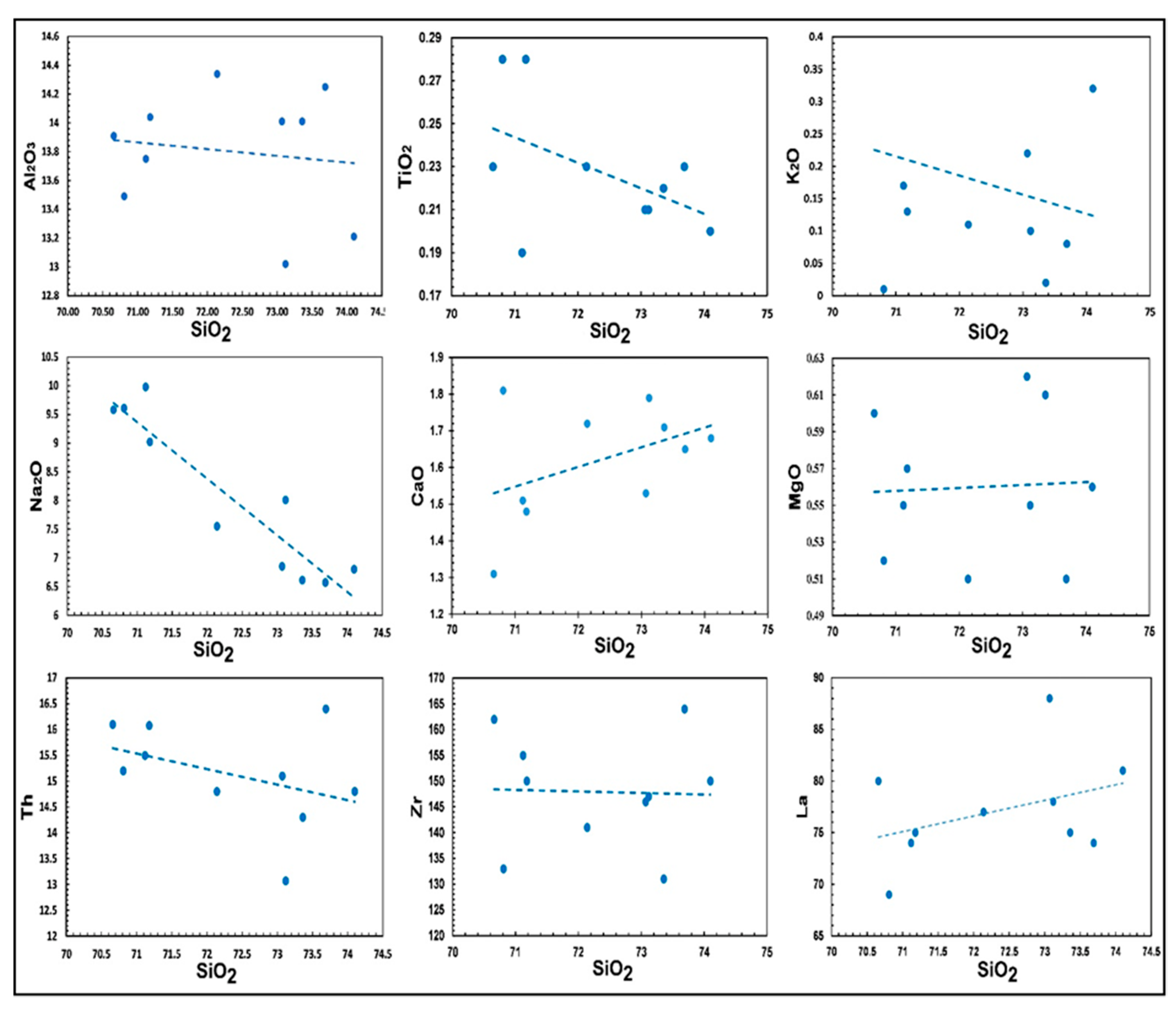

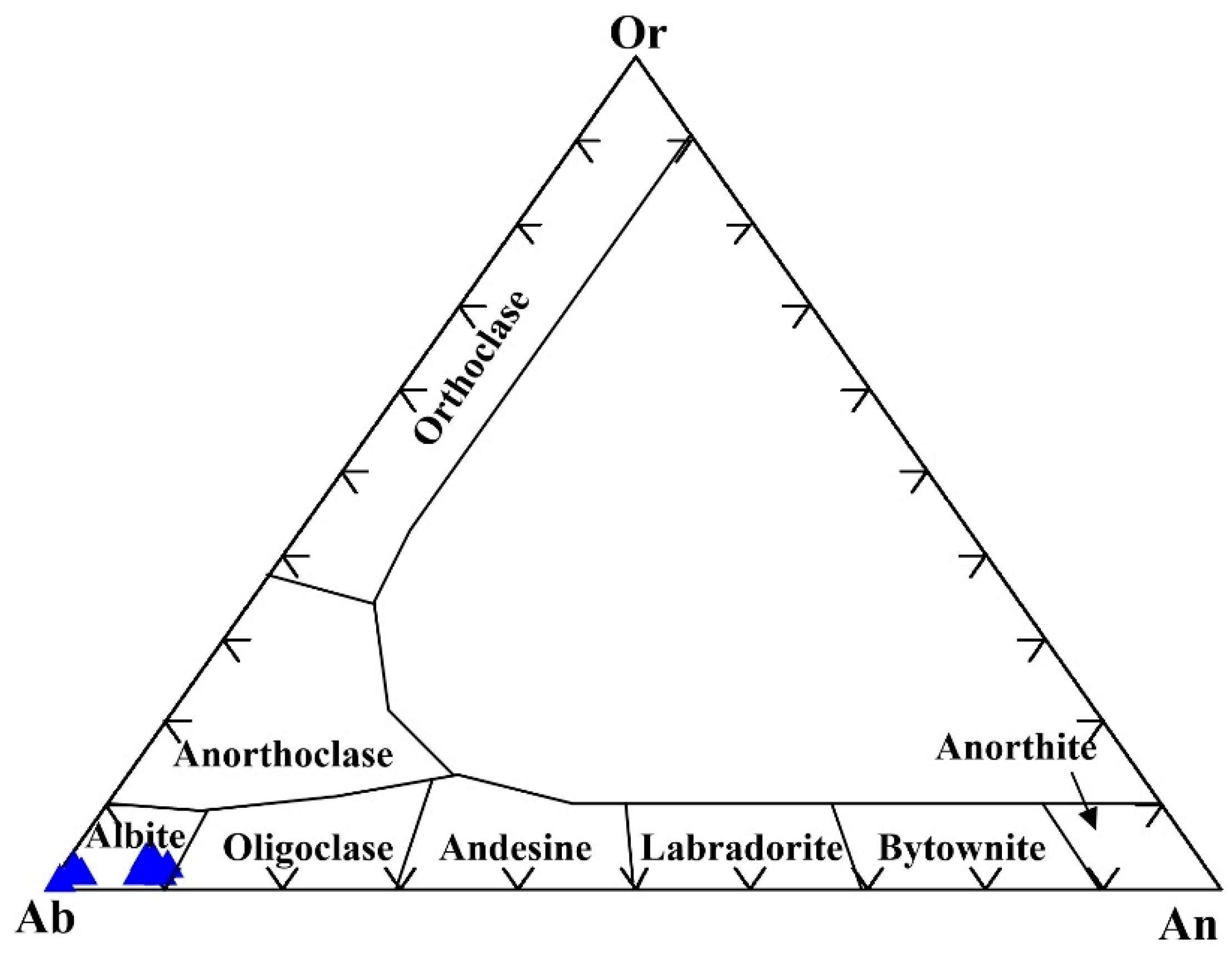
| Trace elements | |||||||||||
| S.No. | 1a | 1b | 2a | 2b | 3a | 3b | 3c | 4 | 9 | 10 | Av. |
| V | 0.48 | 0.39 | 0.50 | 0.32 | 0.45 | 0.55 | 0.41 | 0.43 | 0.41 | 0.39 | 0.43 |
| Cr | 1.00 | 1.18 | 1.05 | 1.38 | 1.16 | 1.00 | 1.28 | 0.88 | 1.13 | 1.07 | 1.11 |
| Co | 1.22 | 7.30 | 7.21 | 7.41 | 1.55 | 7.51 | 1.11 | 1.10 | 1.00 | 1.20 | 3.66 |
| Rb | 0.53 | 0.53 | 0.48 | 0.52 | 0.45 | 0.50 | 0.47 | 0.52 | 0.52 | 0.50 | 0.50 |
| Ba | 0.58 | 0.53 | 0.55 | 0.53 | 0.58 | 0.53 | 0.52 | 0.56 | 0.53 | 0.52 | 0.54 |
| Sr | 0.99 | 1.27 | 1.28 | 1.22 | 1.17 | 1.20 | 1.17 | 1.00 | 1.11 | 1.25 | 1.17 |
| Nb | 3.71 | 3.86 | 3.10 | 3.62 | 3.67 | 3.38 | 3.24 | 3.33 | 3.76 | 3.43 | 3.51 |
| Ta | 0.09 | 0.13 | 0.13 | 0.13 | 0.18 | 0.08 | 0.10 | 0.09 | 0.19 | 0.18 | 0.13 |
| Zr | 0.75 | 0.84 | 0.86 | 0.86 | 0.93 | 0.89 | 0.83 | 0.94 | 0.81 | 0.76 | 0.85 |
| Hf | 0.74 | 0.71 | 0.71 | 0.71 | 0.95 | 0.76 | 0.71 | 0.77 | 0.84 | 0.71 | 0.76 |
| Y | 0.75 | 0.95 | 0.85 | 0.78 | 0.50 | 0.75 | 0.55 | 0.60 | 0.75 | 0.58 | 0.71 |
| Pb | 3.05 | 3.42 | 2.74 | 3.11 | 2.58 | 2.89 | 3.00 | 3.16 | 3.26 | 2.89 | 3.01 |
| Cu | 0.7 | 0.9 | 0.7 | 1.1 | 0.9 | 0.8 | 0.8 | 1.0 | 0.7 | 0.8 | 0.84 |
| Zn | 1.08 | 1.08 | 0.92 | 1.13 | 1.05 | 1.13 | 1.28 | 1.10 | 1.08 | 0.97 | 1.08 |
| U | 1.6 | 1.7 | 1.6 | 2.0 | 2.1 | 1.9 | 1.7 | 2.1 | 1.6 | 1.7 | 1.80 |
| Th | 0.8 | 0.8 | 0.9 | 0.9 | 0.9 | 0.9 | 0.9 | 1.0 | 0.9 | 0.9 | 0.89 |
| Rare earth elements | |||||||||||
| La | 1.36 | 1.42 | 1.47 | 1.36 | 1.45 | 1.35 | 1.60 | 1.35 | 1.40 | 1.25 | 1.40 |
| Ce | 1.90 | 1.72 | 1.86 | 1.83 | 1.90 | 1.68 | 1.82 | 1.58 | 1.65 | 1.79 | 1.77 |
| Pr | 0.45 | 0.45 | 0.45 | 0.45 | 0.45 | 0.68 | 0.45 | 0.68 | 0.68 | 0.80 | 0.56 |
| Nd | 2.05 | 2.27 | 2.19 | 2.11 | 1.65 | 1.73 | 1.49 | 1.73 | 1.70 | 1.92 | 1.88 |
| Sm | 1 | 1.6 | 1.1 | 1.4 | 1.1 | 1.2 | 1.2 | 1.5 | 1 | 1.1 | 1.22 |
| Eu | 0.63 | 0.63 | 0.63 | 0.63 | 0.63 | 0.63 | 0.63 | 0.63 | 0.63 | 0.63 | 0.63 |
| Gd | 0.3 | 0.6 | 0.5 | 0.4 | 0.5 | 0.6 | 0.6 | 0.6 | 0.4 | 0.5 | 0.5 |
| Tb | 0.63 | 0.63 | 0.63 | 0.63 | 0.63 | 0.63 | 0.63 | 0.63 | 0.63 | 0.63 | 0.63 |
| Dy | 0.42 | 0.56 | 0.56 | 0.42 | 0.69 | 0.42 | 0.42 | 0.56 | 0.69 | 0.69 | 0.54 |
| Ho | 0.50 | 0.60 | 0.50 | 0.90 | 0.50 | 0.42 | 0.50 | 0.43 | 0.43 | 0.41 | 0.52 |
| Er | 0.25 | 0.25 | 0.25 | 0.25 | 0.25 | 0.25 | 0.25 | 0.25 | 0.25 | 0.25 | 0.25 |
| Tm | 1.00 | 2.37 | 1.13 | 1.17 | 1.37 | 1.27 | 1.23 | 1.47 | 2.37 | 2.63 | 1.60 |
| Yb | 0.5 | 0.5 | 0.5 | 0.75 | 0.5 | 0.25 | 0.5 | 0.5 | 0.25 | 0.5 | 0.48 |
| Lu | 0.83 | 0.83 | 0.83 | 0.83 | 0.83 | 0.83 | 0.83 | 0.83 | 0.83 | 0.83 | 0.83 |
Publisher’s Note: MDPI stays neutral with regard to jurisdictional claims in published maps and institutional affiliations. |
© 2022 by the authors. Licensee MDPI, Basel, Switzerland. This article is an open access article distributed under the terms and conditions of the Creative Commons Attribution (CC BY) license (https://creativecommons.org/licenses/by/4.0/).
Share and Cite
El-Desoky, H.M.; Abdel-Rahman, A.M.; Ene, A.; Khalil, A.E.; Fahmy, W.; Zakaly, H.M.H.; Awad, H.A. Origin and Heavy Metals of Plagio-Granites in Egyptian Shield Oceanic Complexes: A Case Study of Abu Dabbab Area, Central Eastern Desert, Egypt. Minerals 2022, 12, 1093. https://doi.org/10.3390/min12091093
El-Desoky HM, Abdel-Rahman AM, Ene A, Khalil AE, Fahmy W, Zakaly HMH, Awad HA. Origin and Heavy Metals of Plagio-Granites in Egyptian Shield Oceanic Complexes: A Case Study of Abu Dabbab Area, Central Eastern Desert, Egypt. Minerals. 2022; 12(9):1093. https://doi.org/10.3390/min12091093
Chicago/Turabian StyleEl-Desoky, Hatem M., Ahmed M. Abdel-Rahman, Antoaneta Ene, Ahmed E. Khalil, Wael Fahmy, Hesham M. H. Zakaly, and Hamdy A. Awad. 2022. "Origin and Heavy Metals of Plagio-Granites in Egyptian Shield Oceanic Complexes: A Case Study of Abu Dabbab Area, Central Eastern Desert, Egypt" Minerals 12, no. 9: 1093. https://doi.org/10.3390/min12091093








